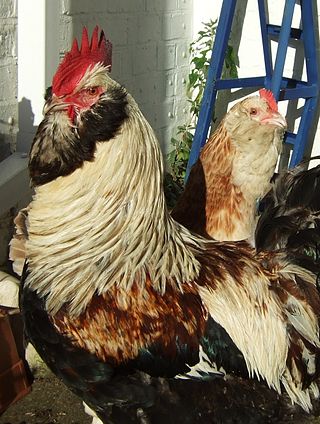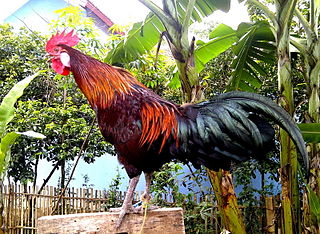
Poultry are domesticated birds kept by humans for the purpose of harvesting animal products such as meat, eggs or feathers. The practice of raising poultry is known as poultry farming. These birds are most typically members of the superorder Galloanserae (fowl), especially the order Galliformes. The term also includes waterfowls of the family Anatidae but does not include wild birds hunted for food known as game or quarry.

The chicken is a large and round short-winged bird, domesticated from the red junglefowl of Southeast Asia around 8,000 years ago. Most chickens are raised for food, providing meat and eggs; others are kept as pets or for cockfighting.

The Leghorn, Italian: Livorno or Livornese, is a breed of chicken originating in Tuscany, in central Italy. Birds were first exported to North America in 1828 from the Tuscan port city of Livorno, on the western coast of Italy. They were initially called "Italians", but by 1865 the breed was known as "Leghorn", the traditional anglicisation of "Livorno". The breed was introduced to Britain from the United States in 1870. White Leghorns are commonly used as layer chickens in many countries of the world. Other Leghorn varieties are less common.

The red junglefowl is a tropical bird in the family Phasianidae. It ranges across much of Southeast Asia and parts of South Asia. It was formerly known as the bankiva or bankiva fowl. It is the species that gave rise to the chicken ; the grey junglefowl, Sri Lankan junglefowl and green junglefowl have also contributed genetic material to the gene pool of the chicken.

Breed broiler is any chicken that is bred and raised specifically for meat production. Most commercial broilers reach slaughter weight between four and six weeks of age, although slower growing breeds reach slaughter weight at approximately 14 weeks of age. Typical broilers have white feathers and yellowish skin. Broiler or sometimes broiler-fryer is also used sometimes to refer specifically to younger chickens under 2.0 kilograms, as compared with the larger roasters.

The Ancona is a breed of chicken which originated in the Marches, region of Italy, but which was bred to its present type mainly in the United Kingdom in the nineteenth century. It is named after the city of Ancona, capital of the Marche. It is popular in Britain and the United States, but uncommon in Italy; an initiative to re-establish it in its native area and preserve its biodiversity was launched in 2000. There are also Ancona bantams.
The Croad Langshan is an old, heavy, soft-feathered chicken breed which probably originated in China.

The Bekisar, or Ayam Bekisar, is the first generation hybrid offspring of the green junglefowl and domesticated red junglefowl from Java. The roosters have a glossy blackish green plumage and are highly prized for their loud clear calls and striking colouration, while the hens are usually dull and infertile.

The New Hampshire Red or New Hampshire is an American breed of chicken. It was developed in the early twentieth century in the state of New Hampshire by selective breeding of Rhode Island Red stock; no other breed was involved. It is fast-growing, early-maturing, quick-feathering, and yields a meaty carcass. Mature birds are a light or medium red in color; they may fade in sunlight.

Poultry farming is the form of animal husbandry which raises domesticated birds such as chickens, ducks, turkeys and geese to produce meat or eggs for food. Poultry – mostly chickens – are farmed in great numbers. More than 60 billion chickens are killed for consumption annually. Chickens raised for eggs are known as layers, while chickens raised for meat are called broilers.

The Naked Neck is a breed of chicken that is naturally devoid of feathers on its neck and vent. The breed is also called the Transylvanian Naked Neck, as well as the Turken. The name "Turken" arose from the mistaken idea that the bird was a hybrid of a chicken and the domestic turkey. Naked Necks are fairly common in Europe today, but are rare in North America and very common in South America. The trait for a naked neck is a dominant one controlled by one gene and is fairly easy to introduce into other breeds, however these are hybrids rather than true Naked Necks, which is a breed recognized by the American Poultry Association since 1965, it was introduced in Britain in the 1920s. There are other breeds of naked necked chicken, such as the French naked neck, which is often confused with the Transylvanian, and the naked necked gamefowl.

The Faverolles is a French breed of chicken. The breed was developed in the 1860s in north-central France, in the vicinity of the villages of Houdan and Faverolles. The breed was given the name of the latter village and the singular is thus also Faverolles, not Faverolle. The final "s" is silent in French.

The Ayam Cemani is a rare breed of chicken from Indonesia. They have a dominant gene that causes hyperpigmentation (fibromelanosis), making the chicken mostly black, including feathers, beak, and internal organs. The Cemani is a very popular gamecock for cockfighting in Bali because their thighs have much more muscle compared to other chickens, which leads to them being much faster.

The Siciliana is an ancient Italian breed of chicken from the Mediterranean island of Sicily. It is notable for its unusual double or rose comb, for the early age at which birds reach maturity, and for the unusual shape of the eggs. The Sicilian Buttercup, bred in Australia, Great Britain and the North America, derives from it, but its long separation from the original stock has led to marked differences between the two.
The Kuroiler is a hybrid breed of chicken developed by the Keggfarms Group in Gurgaon, Haryana. Kuroilers are derived from crossing either coloured broiler males with Rhode Island Red females, or, White Leghorn males crossed with female Rhode Island Reds.

Ayam Ketawa, or "laughing chicken", is a breed of chicken originating from the area of Sidenreng Rappang in South Sulawesi, Indonesia. It is one of several breeds of long-crowing chicken prized for the clarity and unusual length of their crows. The crow of Ayam Ketawa cocks has an unusual similarity to a human laugh. The breed was originally held as a status symbol of the Buginese royal family, but has entered into higher popularity in recent times since the fall of the monarchy. Today it is still seen as a symbol of courage, social status and heroism and they compete in contests for the most perfect crow, for the Governor of Sulawesi Cup.

The Ayam Kampong or Ayam Kampung is the chicken breed reported from Indonesia and Malaysia. The name means simply "free-range chicken" or literally "village chicken". In Indonesia, the term ayam kampung refer to indigenous chickens that are raised using traditional free range production techniques by almost every household in the village. It is a diverse population which resulted from the uncontrolled cross-breeding of red jungle-fowl, indigenous Southeast Asian chickens and exotic chickens of various types imported in the late 1800s by European, mainly Dutch and British, settlers.

The broiler industry is the process by which broiler chickens are reared and prepared for meat consumption. Worldwide, in 2005 production was 71,851,000 tonnes. From 1985 to 2005, the broiler industry grew by 158%.

Long-crowing chicken breeds are characterised by the unusually long-drawn-out crow of the cocks, which may in some cases last for up to 60 seconds. The oldest references to long-crowing cocks are from China. Long-crowing breeds are found in the Far East, in Turkey, in the Balkans and in western Germany.
Prelux are commercial chicken crossbreeds of the Slovenian origin, that are being sold under the eponymous trademark by the Biotechnical Faculty of University of Ljubljana. The name is an abbreviation for the Slovenian phrase prevojski luxuriranci, with a word luxuriranci referring to luxuriance (heterosis) or outbreeding enhancement of hybrid offspring, and adjective prevojski referring to the Slovenian settlement Prevoje, where selective breeding was once performed. This name was given to quality layer hens, that are being obtained by crossbreeding three Slovenian traditional breeds of layer hens; Slovenian Barred, Slovenian Brown and Slovenian Silver Hen. The most known and best-selling layer hens of the trademark Prelux are Prelux-Č, Prelux-G and Prelux-R. A part of the selection is also a meat type chicken (broiler), Prelux-BRO.

















